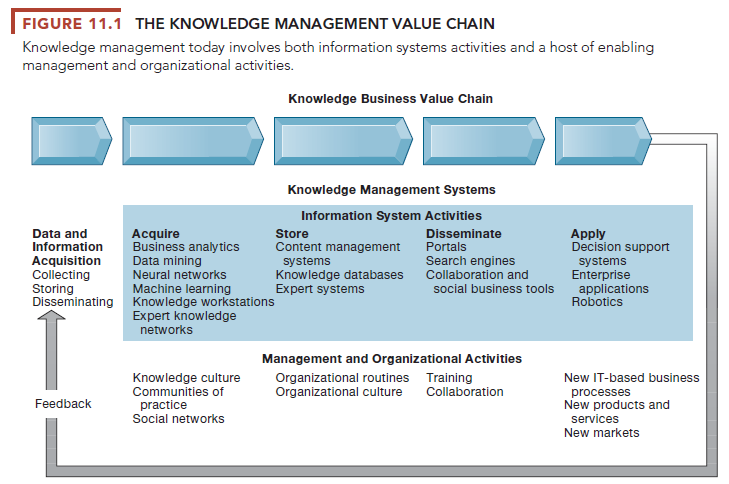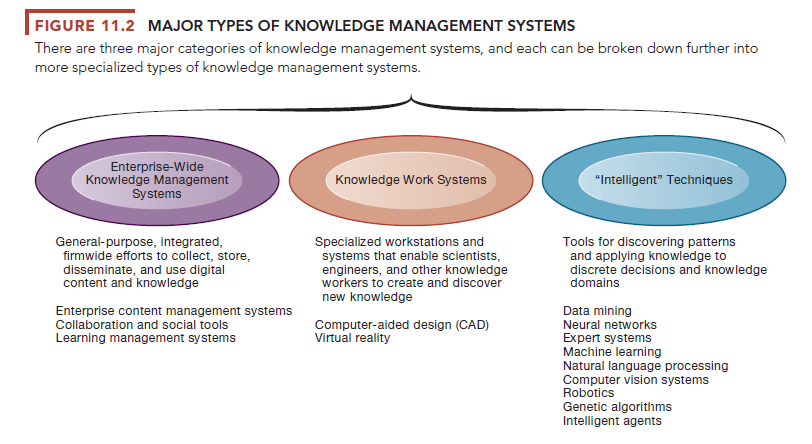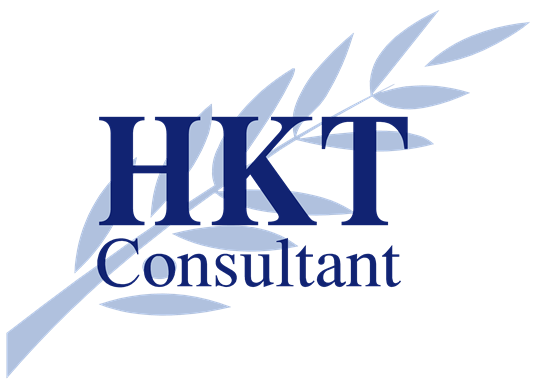Knowledge management and collaboration systems are among the fastest- growing areas of corporate and government software investment. The past decade has shown an explosive growth in research on knowledge and knowledge management in the economics, management, and information systems fields.
Knowledge management and collaboration are closely related. Knowledge that cannot be communicated and shared with others is nearly useless. Knowledge becomes useful and actionable when shared throughout the firm. We have already described the major tools for collaboration and social business in Chapter 2. In this chapter, we will focus on knowledge management systems and be mindful that communicating and sharing knowledge are becoming increasingly important.
We live in an information economy in which the major source of wealth and prosperity is the production and distribution of information and knowledge. At least 20 percent of the total economic output of the United States, $4 trillion, derives from the output of the information and knowledge sectors of the economy, which employs an estimated minimum of 30 million people (U.S. Department of Labor, 2017; Bureau of Economic Analysis, 2018).
Knowledge management has become an important theme at many large business firms as managers realize that much of their firm’s value depends on the firm’s ability to create and manage knowledge. Studies have found that a substantial part of a firm’s stock market value is related to its intangible assets, of which knowledge is one important component, along with brands, reputations, and unique business processes. Well-executed knowledge-based projects have been known to produce extraordinary returns on investment, although the impacts of knowledge-based investments are difficult to measure (Gu and Lev, 2001).
1. Important Dimensions of Knowledge
There is an important distinction between data, information, knowledge, and wisdom. Chapter 1 defines data as flows of events or transactions captured by an organization’s systems that are useful for transacting but little else. To turn data into useful information, a firm must expend resources to organize data into categories of understanding, such as monthly, daily, regional, or store-based reports of total sales. To transform information into knowledge, a firm must expend additional resources to discover patterns, rules, and contexts where the knowledge works. Finally, wisdom is thought to be the collective and individual experience of applying knowledge to the solution of problems. Wisdom involves where, when, and how to apply knowledge.
Knowledge is both an individual attribute and a collective attribute of the firm. Knowledge is a cognitive, even a physiological, event that takes place inside people’s heads. It is also stored in libraries and records, shared in lectures, and stored by firms in the form of business processes and employee know-how. Knowledge residing in the minds of employees that has not been documented is called tacit knowledge, whereas knowledge that has been documented is called explicit knowledge. Knowledge can reside in email, voice mail, graphics, and unstructured documents as well as structured documents. Knowledge is generally believed to have a location, either in the minds of humans or in specific business processes. Knowledge is “sticky” and not universally applicable or easily moved. Finally, knowledge is thought to be situational and contextual. For example, you must know when to perform a procedure as well as how to perform it. Table 11.1 reviews these dimensions of knowledge.
We can see that knowledge is a different kind of firm asset from, say, buildings and financial assets; that knowledge is a complex phenomenon; and that there are many aspects to the process of managing knowledge. We can also recognize that knowledge-based core competencies of firms—the two or three things that an organization does best—are key organizational assets. Knowing how to do things effectively and efficiently in ways that other organizations cannot duplicate is a primary source of profit and competitive advantage that cannot be purchased easily by competitors in the marketplace.

For instance, having a unique build-to-order production system constitutes a form of knowledge and perhaps a unique asset that other firms cannot copy easily. With knowledge, firms become more efficient and effective in their use of scarce resources. Without knowledge, firms become less efficient and less effective in their use of resources and ultimately fail.
Organizational Learning and Knowledge Management
Like humans, organizations create and gather knowledge using a variety of organizational learning mechanisms. Through collection of data, careful measurement of planned activities, trial and error (experimentation), and feedback from customers and the environment in general, organizations gain experience. Organizations that learn adjust their behavior to reflect that learning by creating new business processes and by changing patterns of management decision making. This process of change is called organizational learning. Arguably, organizations that can sense and respond to their environments rapidly will survive longer than organizations that have poor learning mechanisms.
2. The Knowledge Management Value Chain
Knowledge management refers to the set of business processes developed in an organization to create, store, transfer, and apply knowledge. Knowledge management increases the ability of the organization to learn from its environment and to incorporate knowledge into its business processes. Figure 11.1 illustrates the value-adding steps in the knowledge management value chain. Each stage in the value chain adds value to raw data and information as they are transformed into usable knowledge.
In Figure 11.1, information systems activities are separated from related management and organizational activities, with information systems activities on the top of the graphic and organizational and management activities below. One apt slogan of the knowledge management field is “Effective knowledge management is 80 percent managerial and organizational and 20 percent technological.”
In Chapter 1, we define organizational and management capital as the set of business processes, culture, and behavior required to obtain value from investments in information systems. In the case of knowledge management, as with other information systems investments, supportive values, structures, and behavior patterns must be built to maximize the return on investment in knowledge management projects. In Figure 11.1, the management and organizational activities in the lower half of the diagram represent the investment in organizational capital required to obtain substantial returns on the information technology (IT) investments and systems shown in the top half of the diagram.
2.1. Knowledge Acquisition
Organizations acquire knowledge in a number of ways, depending on the type of knowledge they seek. The first knowledge management systems sought to build corporate repositories of documents, reports, presentations, and best practices. These efforts have been extended to include unstructured documents (such as email). In other cases, organizations acquire knowledge by developing online expert networks so that employees can “find the expert” in the company who is personally knowledgeable.

In still other cases, firms must acquire new knowledge by discovering patterns in corporate data via machine learning (including neural networks, gene- netic algorithms, natural language processing, and other AI techniques), or by using knowledge workstations where engineers can discover new knowledge. These various efforts are described throughout this chapter. A coherent and organized knowledge system also requires business analytics using data from the firm’s transaction processing systems that track sales, payments, inventory, customers, and other vital areas as well as data from external sources such as news feeds, industry reports, legal opinions, scientific research, and government statistics.
2.2. Knowledge Storage
Once they are discovered, documents, patterns, and expert rules must be stored so they can be retrieved and used by employees. Knowledge storage generally involves the creation of a database. Document management systems that digitize, index, and tag documents according to a coherent framework are large databases adept at storing collections of documents. Expert systems also help corporations preserve the knowledge that is acquired by incorporating that knowledge into organizational processes and culture. Each of these is discussed later in this chapter and in the following chapter.
Management must support the development of planned knowledge storage systems, encourage the development of corporate-wide schemas for indexing documents, and reward employees for taking the time to update and store documents properly. For instance, it would reward the sales force for submitting names of prospects to a shared corporate database of prospects where all sales personnel can identify each prospect and review the stored knowledge.
2.3. Knowledge Dissemination
Portals, email, instant messaging, wikis, social business tools, and search engine technology have added to an existing array of collaboration tools for sharing calendars, documents, data, and graphics (see Chapter 2). Contemporary technology has created a deluge of information and knowledge. How can managers and employees discover, in a sea of information and knowledge, that which is really important for their decisions and their work? Here, training programs, informal networks, and shared management experience communicated through a supportive culture help managers focus their attention on what is important.
2.4. Knowledge Application
Regardless of what type of knowledge management system is involved, knowledge that is not shared and applied to the practical problems facing firms and managers does not add business value. To provide a return on investment, organizational knowledge must become a systematic part of management decision making and become situated in systems for decision support (described in Chapter 12). Ultimately, new knowledge must be built into a firm’s business processes and key application systems, including enterprise applications for managing crucial internal business processes and relationships with customers and suppliers. Management supports this process by creating—based on new knowledge-new business practices, new products and services, and new markets for the firm.
2.5. Building Organizational and Management Capital: Collaboration, Communities of Practice, and Office Environments
In addition to the activities we have just described, managers can help by developing new organizational roles and responsibilities for the acquisition of knowledge, including the creation of chief knowledge officer executive positions, dedicated staff positions (knowledge managers), and communities of practice. Communities of practice (COPs) are informal social networks of professionals and employees within and outside the firm who have similar work-related activities and interests. The activities of these communities include self-education and group education, conferences, online newsletters, and day-to-day sharing of experiences and techniques to solve specific work problems. Many organizations, such as IBM, the U.S. Federal Highway Administration, and the World Bank, have encouraged the development of thousands of online communities of practice. These communities of practice depend greatly on software environments that enable collaboration and communication.
COPs can make it easier for people to reuse knowledge by pointing community members to useful documents, creating document repositories, and filtering information for newcomers. COPs’ members act as facilitators, encouraging contributions and discussion. COPs can also reduce the learning curve for new employees by providing contacts with subject matter experts and access to a community’s established methods and tools. Finally, COPs can act as a spawning ground for new ideas, techniques, and decision-making behavior.

3. Types of Knowledge Management Systems
There are essentially three major types of knowledge management systems: enterprise-wide knowledge management systems, knowledge work systems, and “intelligent” techniques. Figure 11.2 shows the knowledge management systems applications for each of these major categories.
Enterprise-wide knowledge management systems are general-purpose firmwide efforts to collect, store, distribute, and apply digital content and knowledge. These systems include capabilities for searching for information, storing both structured and unstructured data, and locating employee expertise within the firm. They also include supporting technologies such as portals, search engines, collaboration and social business tools, and learning management systems.
The development of powerful networked workstations and software for assisting engineers and scientists in the discovery of new knowledge has led to the creation of knowledge work systems such as computer-aided design (CAD), visualization, simulation, and virtual reality systems. Knowledge work systems (KWS) are specialized systems built for engineers, scientists, and other knowledge workers charged with discovering and creating new knowledge for a company. We discuss knowledge work applications in detail in Section 11-4.
Knowledge management also includes a diverse group of “intelligent” techniques, such as data mining, expert systems, machine learning, neural networks, natural language processing, computer vision systems, robotics, genetic algorithms, and intelligent agents. These techniques have different objectives, from a focus on discovering knowledge (data mining and neural networks) to distilling knowledge in the form of rules for a computer program (expert systems) to discovering optimal solutions for problems (genetic algorithms). Section 11-2 provides more detail about these “intelligent” techniques.
Source: Laudon Kenneth C., Laudon Jane Price (2020), Management Information Systems: Managing the Digital Firm, Pearson; 16th edition.

You are my intake, I possess few web logs and rarely run out from to post : (.
It absolutely are in agreement with the previous message.